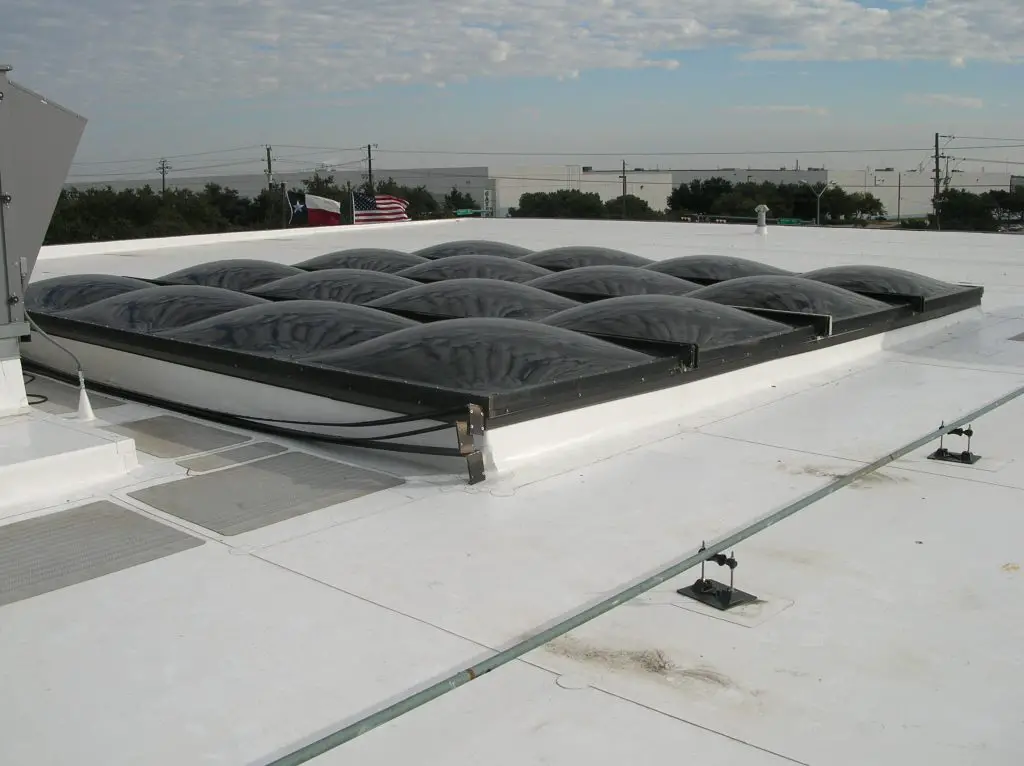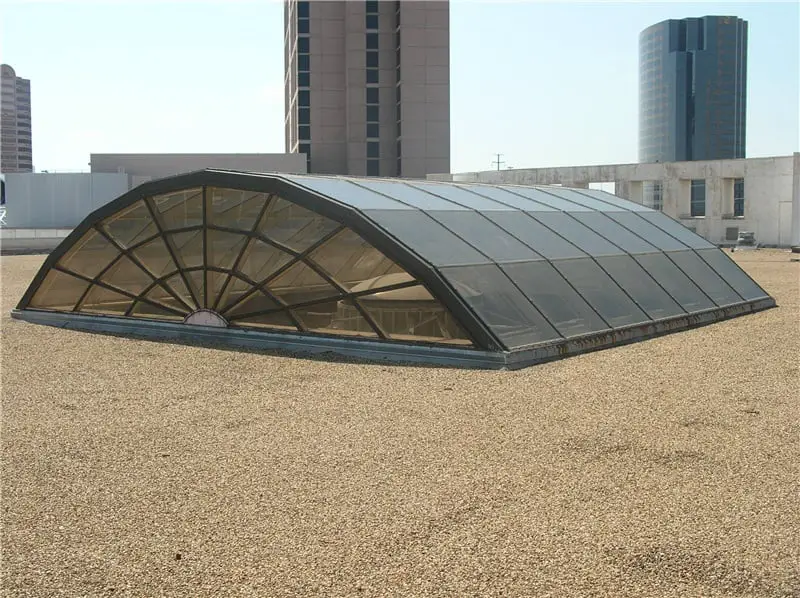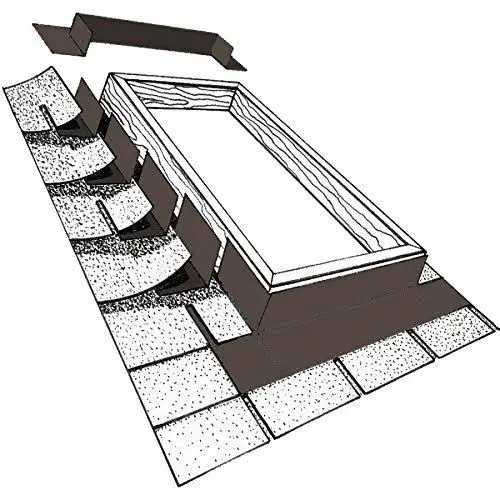Skylights • Introduction to Skylights
By Jack Gray, Roof Online Editor • Updated February 4, 2023

Table of Contents
- Skylights: Introduction
- Skylight Components
- Why Do Skylights Leak?
- Related Articles
- External Sources & References for Skylight Information
Skylights: Introduction
A skylight is essentially a window that is installed in the roof of a building in order to admit natural light into the interior. Skylights come in various shapes, sizes, and styles; although most are modular or come “as-is” from the manufacturer, larger skylights are frequently custom made or custom built. Skylight glazing, or “lenses”, are typically made of glass or some sort of clear plastic, most often acrylic or polycarbonate.
Skylights can be a good way to improve the lighting and ventilation of a building, and they can be an attractive architectural feature as well.
Skylights will typically have a positive effect on the resale value of a home. Just make sure they’re high-quality, have a transferrable warranty, and there isn’t a history of leaks (if there’s a collection of water stains on the ceiling around the skylight, forget about it).
It’s important to carefully consider the design, location, and installer of the skylight in order to ensure that it stays weathertight and problem-free, as well as being energy efficient and safe.

Skylight Components
A skylight consists of several different components that work together to admit natural light into the interior of a building while also providing protection from the elements.
Glazing (typically refers to glass) or the lens (typically refers to non-glass materials): The main and most important component of a skylight is the glass or plastic which lets in the light. This is typically clear or lightly tinted to allow for maximum light transmission.
Frame: The skylight frame surrounds the glazing or lens and holds it in place. The frame can be made of various materials, such as aluminum, vinyl, or wood, and it helps to provide a weathertight seal around the skylight. Skylight frames should not be made out of materials, such as steel, that are subject to significant corrosion.
Sealant: Sealant is often used to fill any gaps or spaces around the skylight to prevent water infiltration. It is typically applied at the flashing around the skylight, where the lens meets the frame, at joints in the frame, and possibly other parts of the skylight. The intent is to create a weathertight seal. The best skylights will not rely on sealant to keep water out.
Sealant is always a maintenance item, and all sealant will fail eventually. You should look for skylights that are structurally configured so that they will keep water out without using sealant. Sealant should should be a secondary, extra level of protection. Avoid skylights that use sealant as the primary line of defense against leaks.
Ventilation: Some skylights are designed to be opened and closed, to allow for ventilation. This allows for increased indoor air quality and temperature control. These skylights will have a mechanism that allows you to open and close the skylight.
Shades or Blinds: Some skylights may also have shades or blinds that can be adjusted to control the amount of light that enters the building.
Flashing: “Flashing” is a technical term that refers to the specially-designed roofing material used to ensure weathertightness where there is an angle change in the roof, between roof sections, at roof penetrations, or where the roof terminates.
With skylights on pitched roofs, there are various flashing systems used, but they should all typically employ some sort of step flashing along the sides of the skylight.
Step flashing consists of small pieces of sheet metal that overlap each other (like shingles) and are interlaced within the surrounding shingles. The individual pieces of step flashing are bent to rise vertically at the skylight frame and the top edges will typically be hidden and protected by the edge of the lens assembly.
Without properly-installed step flashing, your skylight will be completely dependent on sealant performance to remain leak-free. You don’t want that.
The flashing at the top of the skylight (the head flashing) will normally include a larger piece of sheet metal with a flange that spans the width of the skylight and sits on the roof deck under the roof shingles. The flashing at the bottom (the apron flashing) will be similar, but will sit on top of the shingles.
Skylight flashing and instructions on how to install it will often be provided by skylight manufacturers along with the skylight.
For much more detail on flashing skylights check out Installing and Flashing Skylights at the Fine Homebuilding website.

Why Do Skylights Leak?
Skylights are notorious as a source of leaks. Skylights can leak for a variety of reasons, including:
Poor or improper installation: If a skylight is not installed properly, pathways that water can follow into the interior will be the result. Proper skylight installation requires a high level of competence on the part of the installer. Improperly-installed flashing is the number one reason that skylights start leaking as soon as they’re installed, and this is a fairly common occurrence.
Age-related component failure: Many skylight components have a predictable design-life. Certain materials can only take so much thermal cycling and UV exposure before they begin to fail.
Plastic lenses will suffer UV degradation. Rubber or plastic gaskets will degrade with age. Sealant, especially, has a relatively short useful life. As the parts of a skylight degrade or become damaged, the skylight will start to leak.
Materials that are relatively-immune to age-related deterioration include glass and aluminum.
Poor design: Some skylights are simply poorly designed, and will never be properly watertight. Some skylights are installed at locations on the roof where they shouldn’t be. Even a light rain can cause leaks at an otherwise decent skylight if it’s placed within a roof valley!
A properly designed skylight will include a frame height and/or a roof cricket that keeps the rainwater running down the roof from hitting the upslope side of the skylight and forcing its way up and over the base of the frame.
Weather conditions: Severe weather, such as heavy rain, strong winds, and especially a combination of both can put extra stress on the skylight and cause it to leak. Wind-driven rain is often the cause of leaks on otherwise perfectly adequate skylights.
Rain can actually be blown sideways and up into the area where the lens frame hangs over the base of the frame (the skylight curb). If this happens, one trick is to insert backer rod into the gap around the edges of the skylight to block the rain.
Large hailstones can also be a problem, obviously. You should always check the fine print on your skylight warranty to see what size hail the skylight can handle. If you live in a hail-prone area, make sure you get skylights that can handle larger hail.

Lack of maintenance: Regular (at least once a year) maintenance inspections, which include checking and replacing deteriorated sealant, can help prevent skylights from leaking. You should also check the condition of other components.
Skylights do need to be replaced sometimes, and it’s better to find that out by inspecting the skylight than to realize it because of the massive leak in your house.
About the Author
Jack Gray is a principal roof consultant and vice president at the Moriarty Corporation, an award-winning building enclosure consultant firm founded in 1967. He is also the editor of the Roof Online website.

Mr. Gray has worked in the roofing industry for over 25 years, with training and practical experience in roof installation, roof inspection, roof safety, roof condition assessment, construction estimating, roof design & specification, quality assurance, roof maintenance & repair, and roof asset management.
He was awarded the Registered Roof Observer (RRO) professional credential in 2009.
He also served as an infantry paratrooper in the 82nd Airborne Division and has a B.A. from Cornell University. Read full bio.
Related Articles
External Sources & References for Skylight Information
1. General: See this great introductory article on skylights. Available on the website of the US Department of Energy.
2. General: “Why I Hate, Hate, Hate Skylights” by Erik North. Food for thought. Heat loss and condensation issues. Available on the Green Building Advisor site.
3. General: National Fenestration Rating Council (NFRC): The NFRC is an independent non-profit organization that establishes objective window, door, and skylight energy performance ratings to help you compare products and make informed purchase decisions.
4. General: Department of Energy’s Energy Star Program: ENERGY STAR® is the government-backed symbol for energy efficiency, providing simple, credible, and unbiased information that consumers and businesses rely on to make well-informed decisions. Here’s a link to their Residential Windows, Doors & Skylights page.
5. Technical: See this in-depth introductory technical article about skylights at the Whole Building Design Guide site, which is maintained by the National Institute of Building Sciences. It’s a very good page.
6. Technical: “Performance of Tubular Daylighting Devices” is a detailed article from 2014 available on the National Research Council Canada website. Well worth reading if you’re interested in or considering these energy-saving devices.
7. Technical: See this product data sheet for the technical characteristics of prefabricated skylights at the Wasco Skylights website. This is only an example and other products and brands may be different.
8. Technical: Another article worth taking a look at is “Daylighting” on the Whole Building Design Guide site. The article covers much more than skylights, but it helps you understand skylights better by putting them into a broader context.
